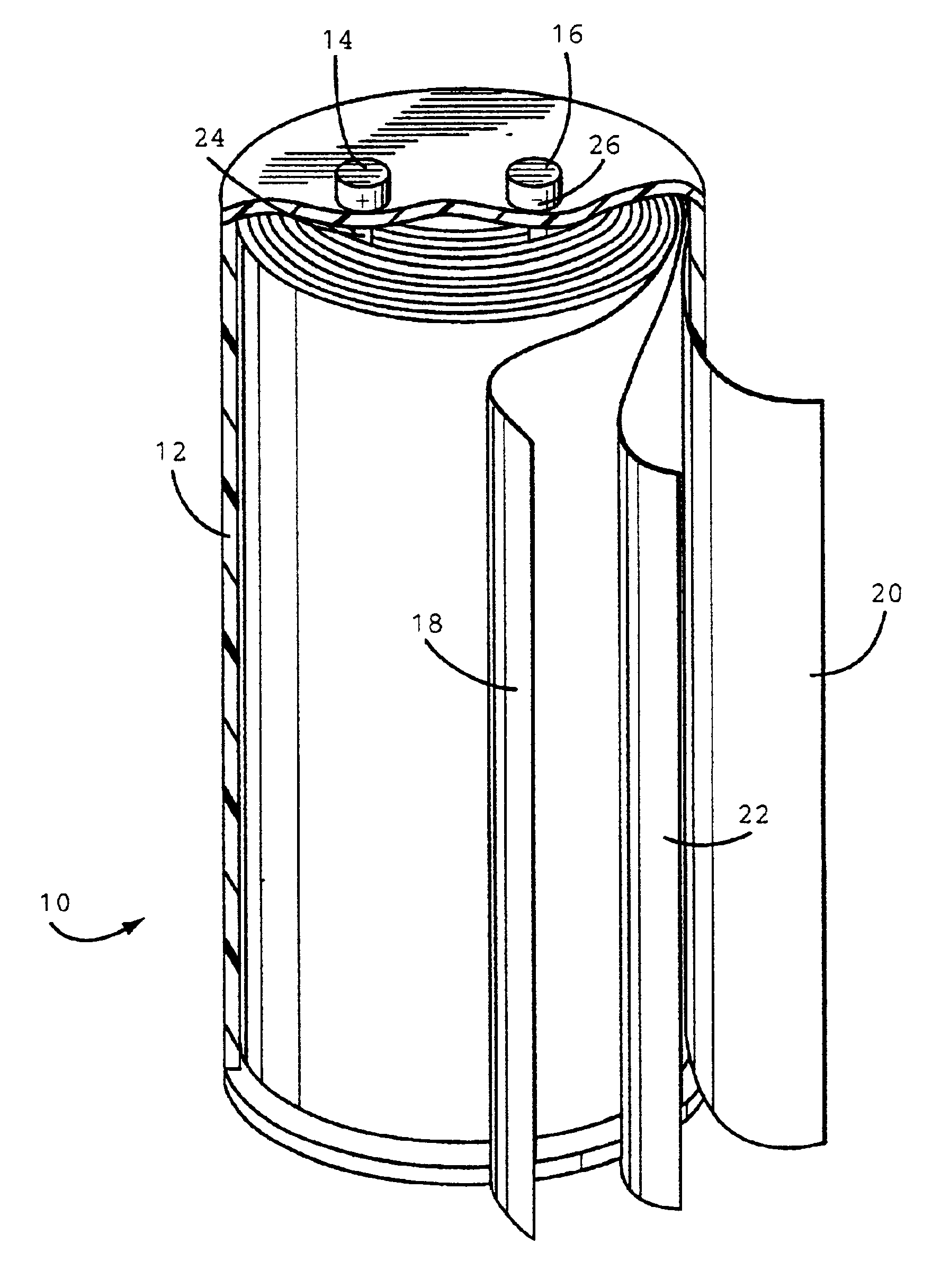High ionic conductivity gel polymer electrolyte for rechargeable polymer batteries
a polymer battery and high ionic conductivity technology, applied in the direction of non-aqueous electrolyte cells, cell components, sustainable manufacturing/processing, etc., can solve the problems of unsatisfactory use of room-temperature lithium rechargeable batteries, difficult to use such electrolytes in practice, and inability to further processing, etc., to achieve low vapor pressure, light weight, and low discharge rate
- Summary
- Abstract
- Description
- Claims
- Application Information
AI Technical Summary
Benefits of technology
Problems solved by technology
Method used
Image
Examples
example 1
[0028]An anode active material was prepared by dissolving 100 g of poly(vinylidene fluoride) (PVDF, Solvay 1012) into 800 g of 1-methyl-2-pyrrolidone (NMP, Aldrich) using a plenary mixer. 1000 g of mesophase carbon micro beads (MCMB 25-28, Osaka gas) and 15 g of acetylene black (Chevron) were added into the PVDF solution and mixed by a plenary mixer. The anode active material slurry was coated on both surfaces of a copper foil using a die coater, dried and pressed to prepare a 200 μm thickness anode.
[0029]A cathode active material was prepared by dissolving 50 g of PVDF (Solvay) was dissolved into 1100 g of NMP (Aldrich) using a plenary mixer. 1000 g of LiCoO2 (Seimi) and 40 g of acetylene black were added into the PVDF solution and mixed by plenary mixer. The cathode active material slurry was coated on both surfaces of an aluminum foil using a die coater, dried and pressed to prepare a 180 um thickness cathode
[0030]The anode, cathode and separator (25 μm, Celpard® 2300 microporous...
example 2
[0031]A plastic case containing an anode, cathode and separator was prepared by the same procedure as in Example 1 except a polyethylene separator (13 μm Celgard® K835 microporous film) was used.
example 3
[0032]1.4 g of poly(2-vinylpyridine-co-styrene), PVPS: Aldrich, was dissolved into 100 g of 1M LiPF6 in 1:1:1 v % ethylene carbonate:diethyl carbonate:dimethyl carbonate (EC:DEC:DMC. Ferro 7500) at room temperature. Subsequently, 0.7 g of α,α′-dibromo-m-xylene (DBX, Aldrich) was then mixed with the solution. DBX was purified before using by sublimation at 65° C. or by a recrystallization method in a 1:3 mixture solvent of acetone and ethanol.
[0033]The resultant electrolyte solution was checked to determine its ionic conductivity at 25° C. both before and after it was gelled using an Oaklon conductivity meter. The ionic conductivity of the electrolyte solution without gelling agent was determined to be 7.8×1031 3 S / cm while the ionic conductivity of the electrolyte gel was determined to be 7.3×10 −3 S / cm. The gel electrolyte employing 1M LiPF6 in 1:1 wt. % EC:DMC (EM30) without gelling agent showed 1.1×10−2 S / cm but the ionic conductivity of the electrolyte gel was 1.0×10−2 S / cm at 2...
PUM
| Property | Measurement | Unit |
|---|---|---|
| Electrical conductivity | aaaaa | aaaaa |
| Electrical conductivity | aaaaa | aaaaa |
| Fraction | aaaaa | aaaaa |
Abstract
Description
Claims
Application Information
 Login to View More
Login to View More - R&D
- Intellectual Property
- Life Sciences
- Materials
- Tech Scout
- Unparalleled Data Quality
- Higher Quality Content
- 60% Fewer Hallucinations
Browse by: Latest US Patents, China's latest patents, Technical Efficacy Thesaurus, Application Domain, Technology Topic, Popular Technical Reports.
© 2025 PatSnap. All rights reserved.Legal|Privacy policy|Modern Slavery Act Transparency Statement|Sitemap|About US| Contact US: help@patsnap.com


